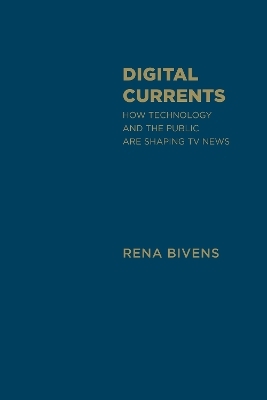
Digital Currents
University of Toronto Press
978-1-4875-2097-7 (ISBN)
- Titel z.Zt. nicht lieferbar
- Versandkostenfrei
- Auch auf Rechnung
- Artikel merken
Using interviews with more than one hundred journalists from eight networks in Canada and the United Kingdom, Rena Bivens takes the reader inside TV newsrooms to explore how news organisations are responding to the paradigmatic shifts in media and communication practices. The first book to examine the many ways that the public has entered the production of mainstream news, Digital Currents underscores the central importance of media literacy in the age of widespread news sources.
Rena Bivens is a Government of Canada Banting Fellow in the School of Journalism and Communication at Carleton University.
Acknowledgments
Chapter 1: Digital Media, Cultural Shifts and Television News Production
The Public’s Arrival
Focus of this Book
A Note on Causation: Technologies and Society
User-Generated Content and Citizen Journalism
Social Networking Services
Television News Organizations: The Hierarchical Structure
Canada versus the UK
General Path and Control Structure of a Television News Item
Bulletins, 24-hour News and Convergence
Structure of this Book
Chapter 2: Constraining News Production: The View from the 20th Century
Evaluating the Literature
The Two Phases of Research: An Obsession with Constraints
Exposing the Social Construction of News
Planning Routines: Relevance of the News Diary
The Importance of Logistics
Society’s Information Producers
The Reign of News Agencies
Pre-Packaged PR News
The Requirements of Objectivity and Impartiality
The Relationship between Objectivity and Sources
Official Sources and Production Routines
Internal and External Pressures
Policy, Routinized Meetings and Editorial Control
Incorporating External Pressure into Daily Practice
Ensuring Conformity within News Organizations
Complexities of the Broadcaster-State Relationship
Instances of Direct Government Intervention
Shared News Values
Images
Importance, Interest and Entertainment
Size, Proximity and Race
Immediacy
Considering the Audience
Summary
Chapter 3: The Technology - Autonomy-Constraint Model
Description of the Model
Phases of News Production
Autonomy-Constraint Ratio
Analysis Using the TAC Model and Ratio
Low Autonomy-Constraint Ratio: Transmission Phase – Television
Balanced Autonomy-Constraint Ratio: Transmission Phase – Digital Media
Balanced Autonomy-Constraint Ratio: Intake/Selection and Assignment Phase
Balanced Autonomy-Constraint Ratio: Storywriting Phase
High Autonomy-Constraint Ratio: Newsgathering Phase
Summary
Chapter 4: Intake Phase – Information Producers and News Flow
Established Actors
News Agencies
Other News Organizations
Official Sources and the Public Relations Industry
News Bureaus
Unconventional Actors
News Flow Patterns
Development of Public News Production
Social Media
Breaking News
Organizational Changes
Credibility and the ‘Bloggers versus Journalists’ Debate
Summary
Chapter 5: Selection and Assignment Phase
Executive Producers and the Assignment Relationship
General Assignment Reporters
Beat Reporters: The Parliamentary Correspondent
Foreign Correspondents
Investigative Journalism
Digital News Agency Feeds and Social Networking
Inside the Editorial Conference
Institution-Driven News
Creating Themes and Adding the Personal Element
Subjectivity
Line-up
Retaining Flexibility
News Values
Images: UGC, Social Media and Digital Graphics
Interest and Importance
Proximity
Immediacy and Being First
Complicating Factors: Online News, Social Media and Conglomeration
Speed versus Accuracy
Immediacy and Being Live
Summary
Chapter 6: Newsgathering, Storywriting and Transmission Phases
Issues of Control
Implicit versus Explicit Control
Editorial Control
Presenters
Packages
Lives
J-Blogging
Social Networking Services
Language
Top-Down Control
Selecting Sources, Challenging Officials and Maintaining Balance
Digital Media and Newsgathering
Research
Locating Sources
Resistance versus the New Cohort
Newsroom Technologies and Storywriting
Non-Linear Editing
Server Technology
Speed and Cost
Improved Workflow
Archival Material
Transmission and Immediacy
Transmitting from the Field
Critiques of Live Coverage
Social Networking Services
Summary
Chapter 7: External Pressures – Audiences, Governments and PR
Audiences
Judging Audience Needs
Linking Immediacy to Audience Expectations
Interactivity
Complaints
Campaigns, Evidence and Blogs
Exposuregates and Retaining Credibility
Government and PR Pressures
Public Relations: The Israeli-Palestinian Conflict
Resisting Pressure
Lack of Context and History
Time Constraints and the Nature of Television
Audience Attention Spans
Top-Down Pressure
Solutions: Go Online?
Summary
Chapter 8: Making News: Power, Journalists and the Public
Appendix: List of Interviews
References
| Erscheint lt. Verlag | 21.1.2014 |
|---|---|
| Zusatzinfo | 1 figure |
| Verlagsort | Toronto |
| Sprache | englisch |
| Gewicht | 500 g |
| Themenwelt | Sozialwissenschaften ► Kommunikation / Medien ► Medienwissenschaft |
| ISBN-10 | 1-4875-2097-2 / 1487520972 |
| ISBN-13 | 978-1-4875-2097-7 / 9781487520977 |
| Zustand | Neuware |
| Haben Sie eine Frage zum Produkt? |